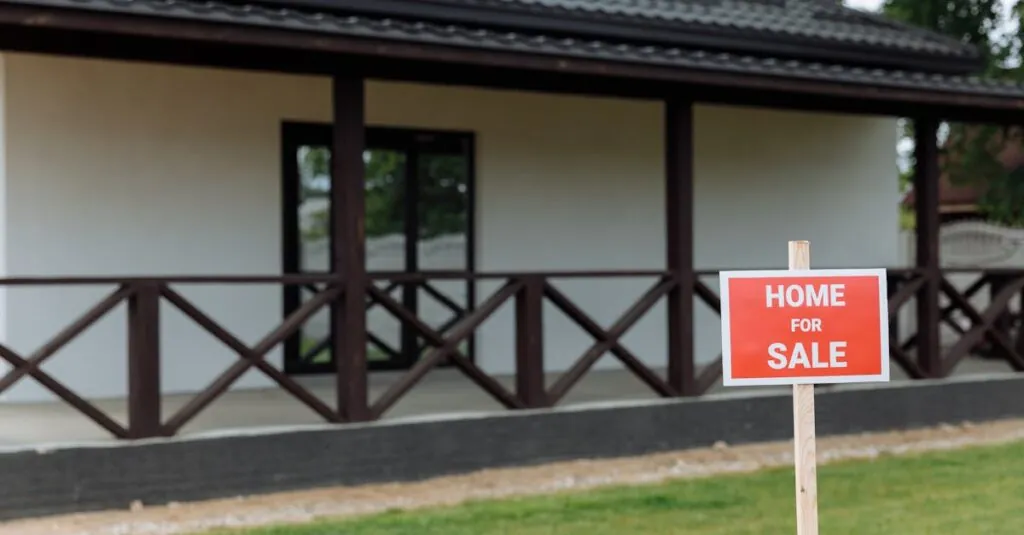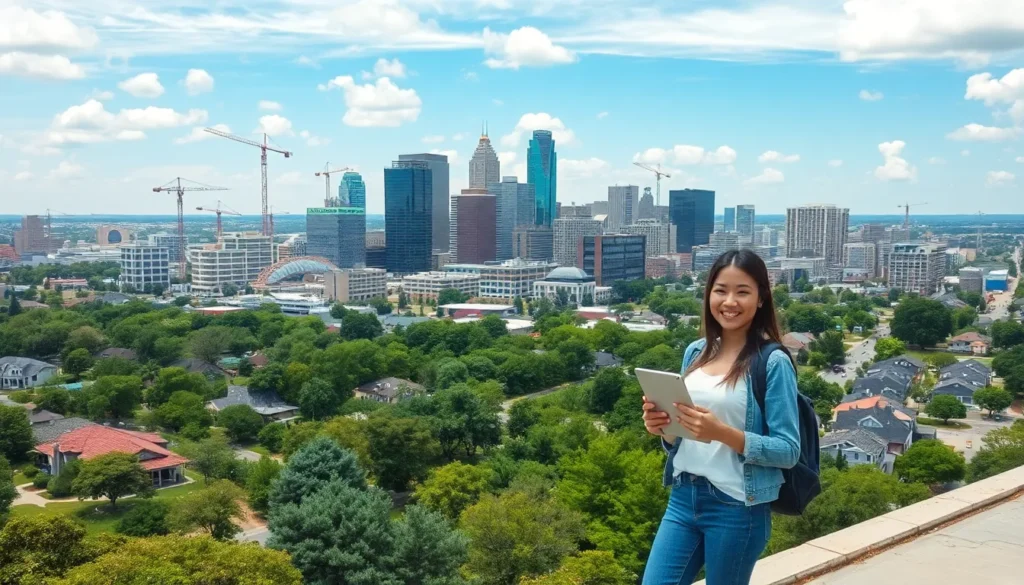In a world where concrete jungles seem to sprout overnight, land conservation and real estate are having a showdown that’s more thrilling than a reality TV finale. While developers dream of building the next big thing, environmentalists are waving their flags, reminding everyone that Mother Nature called and she wants her land back. This tug-of-war isn’t just about pretty parks versus luxury condos; it’s about finding that sweet spot where prosperity meets preservation.
Table of Contents
ToggleOverview of Land Conservation and Real Estate
Land conservation involves protecting natural spaces from development. Real estate development focuses on creating new properties to meet market demand. These two areas often clash, as developers pursue projects that can lead to habitat destruction. Environmentalists argue that preserving land is crucial for biodiversity and ecosystem health.
The balance between these competing interests is delicate. Regulatory measures, like zoning laws and conservation easements, help mitigate the impact of development. Local and federal initiatives can provide funding for conservation efforts while allowing responsible development to occur.
A significant aspect of this relationship includes the economic benefits of land conservation. Protecting natural areas can enhance property values in nearby regions. Studies show that homes near parks or preserved land tend to sell for higher prices. Developers sometimes face pressure from communities that prioritize green spaces.
Communities often engage in discussions about the value of land conservation. Stakeholders, including residents and local governments, weigh the benefits of new developments against the need for environmental protection. Sustainability efforts in real estate aim to incorporate eco-friendly practices into new projects.
Investors increasingly seek properties that align with sustainability goals. These trends signal a shift in priorities, indicating that long-term value lies in responsible development and conservation. By understanding these dynamics, real estate professionals can better navigate the complexities of land use.
Importance of Land Conservation
Land conservation plays a vital role in protecting ecosystems and maintaining environmental balance. It safeguards areas critical for wildlife habitats and preserves biodiversity.
Environmental Benefits
Ecosystems thrive in conserved land areas. Preservation of these spaces protects water quality by filtering pollutants. Natural habitats support a variety of species, promoting genetic diversity and ecological resilience. Additionally, conserved lands contribute to carbon sequestration, helping mitigate climate change effects. Flood management systems improve in areas where wetlands remain intact. Quality of air improves with the preservation of forests and green spaces, providing a healthier environment for nearby communities.
Economic Advantages
Economic growth benefits from land conservation initiatives. Property values often increase in proximity to preserved areas, attracting new residents and businesses. Tourism thrives in regions with protected natural landscapes, bolstering local economies. Job creation occurs in conservation and sustainable tourism sectors, contributing to community stability. Moreover, long-term savings arise from reduced infrastructure costs associated with managing environmental resources. Sustainable practices within real estate lead to increased investments, as eco-friendly developments attract discerning buyers.
Challenges in Balancing Development and Conservation
Balancing land conservation and real estate development presents significant challenges. Conflicting interests between developers and environmentalists persist.
Conflicting Interests
Developers aim to maximize profits by expanding residential or commercial properties. Environmentalists prioritize preserving natural habitats and biodiversity. These opposing goals create tension in many communities. Developers often highlight the economic benefits of new properties, such as job creation and increased tax revenue. In contrast, environmentalists stress the long-term advantages of conservation, including ecosystem stability and enhanced living conditions. Each faction presents compelling arguments. However, overcoming this conflict requires constructive dialogue and collaboration among stakeholders.
Regulatory Hurdles
Zoning laws can complicate the development process, influencing land use decisions. These regulations often limit what developers can build, posing challenges to project feasibility. Additionally, conservation easements may restrict development on certain lands, creating further obstacles. Navigating these regulations demands understanding local frameworks and compliance requirements. Developers sometimes face delays due to the lengthy approval processes associated with environmental reviews. Clear communication between regulatory bodies and developers can improve outcomes. Communities benefit when developers adhere to sustainable practices while meeting housing needs.
Innovative Solutions for Sustainable Practices
Innovative solutions emphasize collaboration and eco-friendly approaches in land conservation and real estate.
Community Engagement
Maximizing community involvement enhances land conservation efforts. Engaging residents fosters a shared vision for sustainable development. Through public forums and workshops, stakeholders discuss environmental concerns and real estate opportunities. Local organizations benefit from partnerships that promote mutual goals. Effective communication builds trust and encourages participation in conservation initiatives. Additionally, when communities support local conservation projects, property values often increase, demonstrating the economic benefits of such collaboration. As a result, ongoing dialogue ensures a balanced perspective on development and environmental protection.
Green Development Strategies
Implementing green development strategies significantly influences sustainable practices. Prioritizing eco-friendly building materials reduces the environmental footprint of real estate projects. Utilizing energy-efficient technologies leads to lower utility costs and promotes long-term savings for property owners. Integrating green spaces into developments not only enhances aesthetic appeal but also improves biodiversity. Investing in renewable energy sources, like solar panels, contributes to the reduction of greenhouse gas emissions. Furthermore, adhering to sustainable building certifications boosts marketability, attracting eco-conscious buyers. Overall, these strategies demonstrate a commitment to responsible development while maximizing economic returns.
Case Studies in Land Conservation and Real Estate
Examining successful initiatives in land conservation and real estate provides valuable insights into effective strategies.
Successful Initiatives
Urban green spaces often demonstrate the positive impacts of conservation in real estate. Many cities have transformed vacant lots into parks, improving community well-being. Notable examples include the High Line in New York City, which converted an old railway into a thriving public park, boosting local property values by up to 20%. Another example is the Green Phoenix initiative, promoting sustainable practices in property development, resulting in a 30% increase in green certification among new constructions. These initiatives highlight the potential synergy between preserving natural spaces and enhancing real estate.
Lessons Learned
Various lessons emerge from the struggles between development and conservation. Communication between developers and environmentalists proves crucial in reaching effective compromises. Previous disputes often stem from a lack of understanding of the ecological benefits that conserved lands provide. Involving local communities in decision-making fosters trust and collaboration, leading to better project outcomes. A focus on long-term benefits rather than immediate profits leads to sustainable success. Conducting impact assessments before developments ensures balanced outcomes while preserving vital ecosystems. These lessons emphasize the need for ongoing dialogue and collaborative solutions in land conservation and real estate.
Balancing land conservation and real estate development is crucial for sustainable progress. As communities face the challenge of protecting natural habitats while meeting housing demands, collaboration among stakeholders becomes essential. By embracing innovative solutions and engaging local voices, it’s possible to create a shared vision that respects both the environment and economic growth.
The shift towards eco-friendly practices in real estate reflects a growing recognition of the long-term benefits of conservation. Successful case studies demonstrate that thoughtful development can enhance property values while preserving vital ecosystems.
Ultimately, fostering dialogue between developers and environmentalists will pave the way for a future where both land conservation and real estate thrive together.













